

How I built an electricity producing wind turbine. Several years ago I bought some remote property in Arizona.
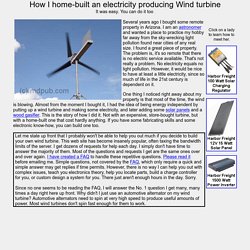
I am an astronomer and wanted a place to practice my hobby far away from the sky-wrecking light pollution found near cities of any real size. I found a great piece of property. The problem is, it's so remote that there is no electric service available. That's not really a problem. No electricity equals no light pollution. One thing I noticed right away about my property is that most of the time, the wind is blowing. Scientists Develop Solar-Powered Wind Turbine for Ultimate Energy Generation. Why settle for one form of renewable energy when you can produce power with two?
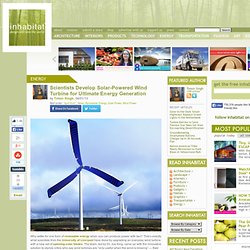
That’s exactly what scientists from the University of Liverpool have done by upgrading an everyday wind turbine with a new set of spinning solar blades. The team, led by Dr. Joe King, came up with the innovative solution to stymie critics who say wind turbines are “only useful when the wind is blowing” — their design doubles the functionality of traditional turbines by incorporating photovoltaic technology. A Quiet Wind Turbine? Tuesday, 29 November 2011 GreenMuze Staff The Eco Whisper designed by Renewable Energy Solutions Australia Holdings Ltd.
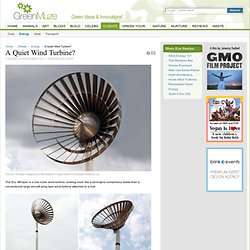
The Eco Whisper is a low noise wind-turbine, looking more like a jet engine compressor blade than a conventional large aircraft wing-type wind-turbine attached to a hub. The Eco Whisper is installed at Geelong, Victoria, Australia, and is designed by Renewable Energy Solutions Australia Holdings Ltd, Brisbane, Australia. The wind turbine uses an automatic slewing mechanism to keep the blades pointing into the wind, and can generate 20kW of power. The Eco Whisper is 21.1m (69.2ft) tall with 6.5m (21.3ft) diameter blades, fitted with an outer cowling that is designed to prevent spanwise airflow, increasing the 30 aluminum blade lifting efficiency and helping generate more power at a given wind speed.
The shorter blades and cowl are claimed to reduce bird deaths and the hinged tower allow the turbine to be maintained or lowered when there are storms. New Wind Turbine Design Can Triple Energy Production. Storing Wind Power Energy in Compressed Air Tanks Could Change the World. Photo: Flickr, CC Capturing the Wind for Later Use, More or Less...
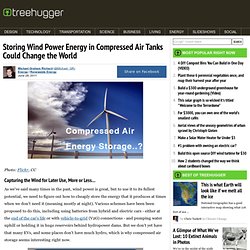
As we've said many times in the past, wind power is great, but to use it to its fullest potential, we need to figure out how to cheaply store the energy that it produces at times when we don't need it (meaning mostly at night). Various schemes have been been proposed to do this, including using batteries from hybrid and electric cars - either at the end of the car's life or with vehicle-to-grid (V2G) connections - and pumping water uphill or holding it in huge reservoirs behind hydropower dams. But we don't yet have that many EVs, and some places don't have much hydro, which is why compressed air storage seems interesting right now. Photo: SustainX One company working on this is SustainX: In conventional compressed-air storage, electricity is used to compress air, which is stored in underground caverns or aquifers.
Technology - Professional Engineering. Wind Power Without the Blades: Big Pics. Japanese breakthrough will make wind power cheaper than nuclear. NOTE: Some major wind projects like the proposed TWE Carbon Valley project in Wyoming are already pricing in significantly lower than coal power -- $80 per MWh for wind versus $90 per MWh for coal -- and that is without government subsidies using today's wind turbine technology.

The International Clean Energy Analysis (ICEA) gateway estimates that the U.S. possesses 2.2 million km2 of high wind potential (Class 3-7 winds) — about 850,000 square miles of land that could yield high levels of wind energy. This makes the U.S. something of a Saudi Arabia for wind energy, ranked third in the world for total wind energy potential. The United States uses about 26.6 billion MWh's, so at the above rate we could satisfy a full one-third of our total annual energy needs. The Impossible Wind Turbine Design That Just Might Work. Wind Energy Published on January 27th, 2009 | by Ariel Schwartz Adam Fuller has dedicated his life— and his life savings— to disproving the wind industry’s claim that vertical turbines are ineffective.

Last week, I had a chance to talk to the Racine, Wisconsin inventor about his 12 foot diameter, 36 foot tall patent-pending wind turbine. "Jet Engine" Wind Turbines Could Quadruple Power Generation. Written by Hank Green on 26/03/08 When we wrote about FloDesign's weird-looking wind turbines a while back, we were pretty excited about the new design.

But we were a little confused by how the things worked. Well, FloDesign seems to have taken my confusion to heart, because they've created a very nice video showing exactly how the turbines work. If you can get over the inspirational music, then you're in for a treat. They take the time to explain a bit about how the turbine actually works, and also show that it's much easier to ship, requires less infrastructure, can be placed closer to people, and can be more tightly spaced in a wind farm.
The new turbines extract three to four times more energy from the wind, and so can be much smaller. New Study: Bigger Is Better When It Comes To Wind Turbines. By Climate Guest Contributor on June 24, 2012 at 10:59 am "New Study: Bigger Is Better When It Comes To Wind Turbines" According to a Swiss study, “the larger the (wind) turbine is, the greener the electricity becomes.”
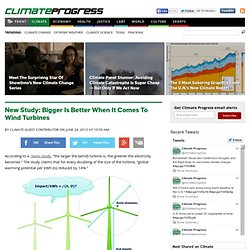
The study claims that for every doubling of the size of the turbine, “global warming potential per kWh (is) reduced by 14%.” The study was conducted by Marloes Caduff and his associates at the Zurich Institute of Environmental Engineering in Zurich, Switzerland. Caduff et al. claim that there are two main reasons for the benefits of larger turbines. Second, recent advances in materials have allowed the turbines to dramatically increase in size without a corresponding increase in mass. According to the researchers, the combined effects of these reasons allow for bigger and better turbines to be produced without using significantly more materials or drastically increasing transportation and assembly costs. Build Your Own Vertical-Axis Wind Turbine. The Zoetrope is a vertical-axis wind turbine (VAWT) made from materials commonly found at your local hardware store and a few easily purchased online, and Applied Sciences has made the decision to “open source” the turbine for everyone who wants to try their hand at making one.

With videos and a downloadable PDF construction guide, it looks like anyone with a menial amount of handyperson abilities could make one for themselves. These type of vertical-axis wind turbines are quiet, really strong, and don’t require too much wind in order to operate efficiently. I am thinking I may just give building one of these a shot myself! About the Author: David Quilty After a varied past of being a test driver for automotive television programs, a Hollywood studio lackey, and an online media sales director, David is now the publisher and editor of The Good Human. 10 Wind Turbines That Push the Limits of Design. What It Is /// The company, WhalePower, has redesigned the typically smooth blades on a turbine, adding a series of ridges, based on tubercles, the bumps on humpback whale fins.
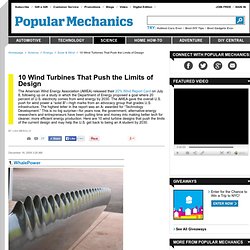
The company says this new blade design could increase annual electrical production for existing wind farms by 20 percent. How It Works /// Humpback whales tilt their fins at steep angles to achieve better lift in the water. Too much tilt, however, has the opposite effect--a loss of lift, called stalling. Tubercles prevent stalling, allowing for more aggressive fin tilts.
WhalePower's tubercle-like structures on the turbine blades allow the blades to have steeper angles--without causing stalling or creating too much drag. Where To Find It /// Testing on the tubercle-enhanced blades began in 2007 at The Wind Energy Institute of Canada in Prince Edward Island. China Now World Leader in Wind and Hydro. Wind Energy Published on October 28th, 2011 | by Susan Kraemer With 42.3 GW of wind power installed, China has now become the new world leader in wind power, having overtaken the US, with 40.2 GW, which itself bypassed the longtime world leader Germany in 2008. After four years of doubling its installed wind power capacity annually between 2006 and 2009, China added a record 16.5 GW in 2010. According to a detailed report(pdf) from the Netherlands Environmental Assessment Agency, nearly 20% of all net additional power generation capacity in China is now wind power, nearly on par with its hydro.
China now leads the world in large-scale hydropower with 21% of global production. Hydropower output increased by 5.3% in 2010 with China accounting for more than half of the growth, due to an increase in capacity and favourable (wet) weather in 2010. US wind installations dropped to half the rate of 2009, when the Obama administration Recovery Act provided a onetime boost. Wind Power. Chris Schilling: Are wind turbines feasible in your town? Chris Schilling This fall, I'm teaching alternative energy at Saginaw Valley State University. I found a very readable and entertaining textbook: Sustainable Energy Without the Hot Air, written by Cambridge University professor of physics, David MacKay.
Science magazine claims the book is, "...a cold blast of reality...a must read analysis.... " This book is a reality check for anyone with influence on energy decisions affecting business or government. In essence, MacKay provides a set of simple and compelling math lessons for those who are considering an investment in renewable energy of any sort. No advanced mathematics required. In this article, I wish to present one of Dr. 1) What are the physical limits to the supply of wind energy in my town; and 2) is that supply big enough to meet local electric demand? The example provided in this article focuses on Saginaw county. Before starting the lesson, we must tackle a pesky language barrier - an energy language barrier.
Turbine Light Powers Highway Lights With Wind. As more and more people across the world adopt cars as their primary mode of transportation, well-lit highways become increasingly important. But how can we sustainably power all those energy-sucking lights? TAK Studio addressed that question in their entry into this year’s Greener Gadgets competition to find the green technology solution of the future.
Dubbed the Turbine Light, their design aims to illuminate our roadways using the power of the wind. This New Wind Turbine Produces Electricity and Water. In our pursuit of clean, renewable energy, wind turbines seem to always take a backseat to solar energy. We’re constantly looking into new ways to harvest the Sun’s energy, but what can you do with something that is essentially an oversized fan? As it turns out, quite a lot.
A French eco-energy company named Eole Water has developed a new wind turbine that can collect wind energy and fresh water from thin air. The company’s WMS1000 wind turbine can condense water vapor from even the most arid weather conditions and produce gallons of drinkable water. Prototype wind turbine condenses 1,000 liters of water a day from desert air. If you live in or travel through a desert region, having access to clean water is always going to be an issue. If you can’t carry enough for your journey, you have to ensure your route allows for a few water bottle refills. But the lack of water in deserts and other arid locations may soon be a thing of the past if a new wind turbine system is implemented on a large scale.
Marc Parent, founder of Eole Water, realized that he could extract water from the air after noticing how much water an air conditioner unit collected. He decided to combine a green energy source with the necessary components for condensing water directly from the air. The end result after 10 years of R&D is the WMS1000 wind turbine, capable of condensing and storing up to 1,000 liters of water every day. The 34 meter tall turbine requires 15mph winds for its 13 meter diameter rotor to turn and generate sufficient energy. Video: An Inflatable, Flying Turbine Goes Higher to Find Stronger Winds. Eco DIYs: Vertical Axis wind turbine made from PVC pipes.